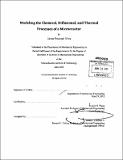| dc.contributor.advisor | Evelyn N. Wang. | en_US |
| dc.contributor.author | Silva, James Emanuel | en_US |
| dc.contributor.other | Massachusetts Institute of Technology. Dept. of Mechanical Engineering. | en_US |
| dc.date.accessioned | 2012-12-13T18:51:28Z | |
| dc.date.available | 2012-12-13T18:51:28Z | |
| dc.date.copyright | 2012 | en_US |
| dc.date.issued | 2012 | en_US |
| dc.identifier.uri | http://hdl.handle.net/1721.1/75678 | |
| dc.description | Thesis (S.B.)--Massachusetts Institute of Technology, Dept. of Mechanical Engineering, 2012. | en_US |
| dc.description | Cataloged from PDF version of thesis. | en_US |
| dc.description | Includes bibliographical references (p. 34). | en_US |
| dc.description.abstract | This thesis seeks to create a high fidelity model of the multiphysics present in a typical microreactor using propane combustion as a fuel source. The system is fully described by energy, momentum, and mass equations, all of which are highly coupled by their dependence on temperature. Using the work done on the S[mu]RE IV microreactor as a basis, this undergraduate thesis implements the relevant equations of a general microreactor model in the finite element software known as COMSOL Multiphysics. Combustion was modeled as a surface reaction occurring on the microchannel walls, with rates modeled based on Arrhenius assumptions. Furthermore, a compressible Navier-Stokes equation was applied to describe the gas flow. Finally, Maxwell-Stefan equations were implemented in order to capture the concentration and temperature dependence of the various species diffusivities. For characterizing the thermal profile, convective, conductive, and radiataive heat transfer modes were all included. However, because this ideal model faced convergence issues due to the complexity of the Maxwell-Stefan diffusion equations, a simpler model is presented. The simpler model assumed general convective and conductive mass transfer, with diffusivity values typical of gas-gas mass transfer utilized. Furthermore, the flow was also simplified to be described by the incompressible Navier- Stokes equation. Temperatures from this simplified simulation ranged from 850-856K as compared to previous results, which showed a range of approximately 850-920K. Furthermore, propane concentration only fell from 0.150 mol m3 to 0.100 mol m 3 while previous results showed complete consumption for the same initial amount. These differences were anticipated and are thereby explained by the simplifications made. Finally, several steps are outlined for future investigation as to the problems facing the ideal model. These steps include analysis not only of the equations implemented by COMSOL, but also of numerical factors that could hinder convergence. Fixing the ideal model should allow for application to various projects that would require chemical or thermal data of such a microreactor. | en_US |
| dc.description.statementofresponsibility | by James Emanuel Silva. | en_US |
| dc.format.extent | 34 p. | en_US |
| dc.language.iso | eng | en_US |
| dc.publisher | Massachusetts Institute of Technology | en_US |
| dc.rights | M.I.T. theses are protected by
copyright. They may be viewed from this source for any purpose, but
reproduction or distribution in any format is prohibited without written
permission. See provided URL for inquiries about permission. | en_US |
| dc.rights.uri | http://dspace.mit.edu/handle/1721.1/7582 | en_US |
| dc.subject | Mechanical Engineering. | en_US |
| dc.title | Modeling the chemical, diffusional, and thermal processes of a microreactor | en_US |
| dc.type | Thesis | en_US |
| dc.description.degree | S.B. | en_US |
| dc.contributor.department | Massachusetts Institute of Technology. Department of Mechanical Engineering | |
| dc.identifier.oclc | 820002302 | en_US |
